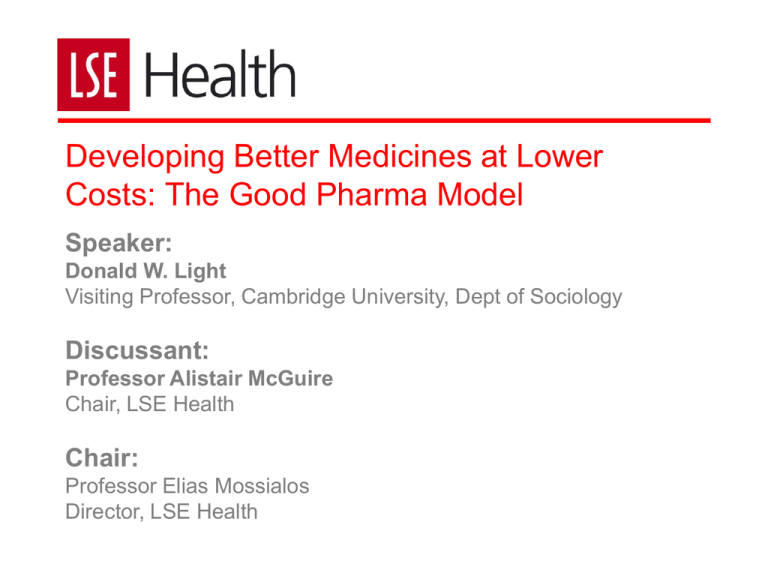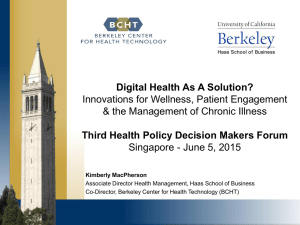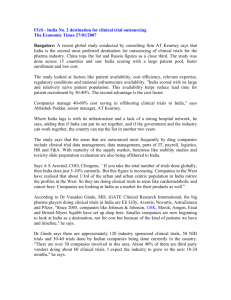Developing Better Medicines at Lower Costs: The Good Pharma Model Speaker: Discussant:
advertisement

Developing Better Medicines at Lower Costs: The Good Pharma Model Speaker: Donald W. Light Visiting Professor, Cambridge University, Dept of Sociology Discussant: Professor Alistair McGuire Chair, LSE Health Chair: Professor Elias Mossialos Director, LSE Health Developing Better Medicines at Lower Costs: The Good Pharma Model Donald W. Light Visiting Professor, Cambridge University, Dept of Sociology Visiting researcher –Princeton University & NYU Medical Ethics Professor of Comparative Health Care Policy Rowan University – School of Osteopathic Medicine London School of Economics LSE Health 16 May 2016 dlight@princeton.edu See www.PharmaMyths.net Based on GOOD PHARMA: the Public Health Model Of the Mario Negri Institute (Palgrave 2015) 2016-Slides LSE May contain errors A Groundswell Against the Dysfunctions of Drug Patents Very high prices & profits with few benefits • Prey on the seriously ill. • Compromise trustworthiness of med knowledge & prescribing Proposals for March-in rights or “eminent domain” on prices that limit access and burden patients. (James Love et al, KEI January 2016) • (Amy Kapczyski & Aaron Kesselheim H Affairs May 2016) Calif Drug Price Relief Act – VA prices Return to limited criteria for patents? (India) An ethical framework for drug development To treat all who are ill or who suffer • Universal health care as a right, a moral duty To develop clinically better medicines for patients • In order to heal, reduce suffering, and prevent, • While minimizing adverse side effects What would developing pharmaceuticals for global health needs look like? Health care systems would identify unmet clinical needs Like WHO’s Priority Medicines for Europe & the World They would fund research to find effective treatments They would test for clinical benefits and harms based on unbiased, scientific trials They would fund a regulator to protect patients from unsafe or ineffective medicines By contrast, 5 troubling ethical concerns described in Bad Pharma: 1. clinical trial designs that compromise clinically valid outcomes, described in Goldacre’s Bad Pharma 2.biased methods of trial organization & analysis for greater profits 3. selectively hiding or biasing outcomes 4. biased publication of medical knowledge 5. pricing and promotion that limit access for those in need Patent-driven research… Exacerbates global health inequality • Global IP regime, led by so-called “free trade agreements” Minimizes real innovation • Patents reward research for minor variations • -Reward producing more patents! • No evidence that IP proliferation has increased the proportion of clinically better drugs (BMJ 2012) • Since 1970s, have decreased from 15% to 7.8% Drug firms fund the FDA & EMA to approve their drugs so that 918 of 980 are clinically minor variations. Superior drugs down from 15% in 1970s to only 7.8%. BAD PHARMA: Companies design trials to minimize evidence of harms and maximize evidence of “benefits” & sales Exclude those more likely to have adverse reactions • Use substitute or surrogate outcomes • Use non-inferiority or placebo designs Often violate principles of research ethics • Biased statistical analysis and conclusions • Hidden data and repackaged evidence can hide risks of serious harms History of SSRI drugs. VIOXX. Why trust Drug Companies to test? We know that research by tobacco companies downplay the harms of smoking We know the National Football League will overlook, under-test, and hide data about the harms of concussions Why wouldn’t we expect drug companies to do the same? • Why have them test their own products?? Prescription Drugs the 4th cause of death 130,000 deaths a year in US • (Institute for Safe Medication Practices Sept 2015) • Drugs about 4 times more lethal than firearms in the USA A major cause of hospitalizations, falls, trucker accidents too • About 2.7 hospitalizations a year in USA alone Are new drugs causing marginally more harm than good? We don’t know. Not tracked. The Inverse Benefit Law of Pharmaceutical Marketing & Promotion The more widely drugs are marketed, the more diluted become their benefits but the more widespread become their risks of harm (AJPH:101:399) Techniques: reduce thresholds for dx and rx -create new diseases and conditions - exaggerate claims of benefits -exaggerate claims of safety (hide evidence of harms) -encourage unproven & off-label uses “Safety” is undertested. Risks get buried Companies define “safe and effective” using indirect or surrogate measures • Independent reviewers find most are little or no better, with large risks of serious harm: • 1 in 5 new drugs lead to a serious warning or withdrawal. Very high! • Faster reviews for “priority” drugs increase this risk to 1 in 3. See Hlth Aff 2014:33:1453. Arch Int Med 2012:172 20 Yrs before Bad Pharma was BAD MEDICINE (Silverman, Lydecker & Lee) The 4th (1976, 1982, 1986, 1992) study of singledrug entities sold in Latin America, Africa & Asia. • 40 sold under 1500 names by 400 companies, mostly local or regional! Details of serious harms, denied by Big Pharma… consumer protests… then warnings added in West, but not in much of the world Needs replication. How much patient harm for profits from un-warned poorer patients? Companies fund the regulators too! -They emphasize minimizing review time & evidence of real benefits or harms • Fewer, shorter trials shifts risks to patients! • Required clinical trials not done – No Fines! • 90% ADR reports from the companies that sell… • Few Warning Letters • Slow, reluctant response to evidence of ADRs • Large backlog of post-market data • Only 10% FDA staff focus on serious harms Govt GAO report (16-192): FDA weak on safety • FDA lacks reliable, accessible data on safety • FDA lacks leadership and resources to assure drugs are safe A low budget priority • Increasing expedited reviews with spotty follow-up testing and no sanctions Published Medical Knowledge A further layer of biases in ghost-managed journal articles, funded by patent profits. Switch end-points, stats. Omit data. • This double bias (of trials, then articles) becomes medical knowledge for teaching, CME, clinical guidelines. Leads to more meds in higher doses than necessary. • FDA does not monitor or inform Drs about these misrepresentations (See Lisa Bero’s studies) Do huge R&D costs justify High Prices? Nobody knows, on purpose. • Costs like $2.6bn per drug never related to revenues • Rhetorical cost estimates (…and very effective!) • Based on undisclosed costs to pharma policy center • Costs of R(esearch) unknowable, highly variable • $2.6bn based on most costly fifth. 4X more than licensed in NCEs. 15X more costly than minor variations. • Half is estimated profits if research had not been done! • Several inflators increase the cost of failures • Taxpayer subsidies cover about 40% Net corp costs Do huge R&D costs justify High Prices? (cont) • Net, median, corporate, deflated R&D costs about 1/10th the gross, average, inflated R&D costs. • About 84% of all funds for basic research from public sources. (“The Entrepreneurial State”) • U.S. tax savings from profits in overseas havens exceed all net R&D costs. Is corporate R&D all paid by taxpayers? • Most drug sales paid by taxpayers • Why not fund R&D and control IP rights? Are patents “essential for innovation”? IP laws privatize knowledge as a public good, to fund “innovative research” • (But companies allocate only 2.2% of revenues to basic research to discover new molecules (BMJ 331:958) • Taxpayers subsidize about 40% (=1.3%, not 17%) Most R&D funds R&D for “innovation” = minor variations for more patents Patents reduce innovative research. • Used to block others. • The opposite of collaborative, shared research Good Pharma: the public health model of the Mario Negri Institute Shows how paid-up R&D can be done for universal health care systems 51 laboratories on 3 campuses Worked out rules, practices to keep research design, data collection, analysis and publication independent of political or commercial influences A community of scientists, sharing and helping each other. An open science model. Promotes cautious use of drugs among physicians, patients & the public Public newsletters, periodic advisories, guidelines for cautious prescribing as little as possible Ch 4 Developed methods that led to the Essential Medicines list • Delisted of ineffective, dangerous drugs Ch 7 Mario Negri Institute, main building at dawn Origins & Principles of the Mario Negri Institute for Pharmacological Research Founded in 1960s by Silvio Garattini and young, talented researchers, dedicated to: • -beneficence through principled research • - independence from corrupting corporate and government practices • - autonomy for beneficence • -non-maleficence Became the leading research institute in Europe for NIH grants, when medicines were not patented • As a societal good. Reasons why the Mario Negri does not patent: To keep research from commercial biases Patenting skews the direction of research at every phase. Patenting fosters secrecy. Obstructs collaboration & innovative research. Patenting for profits undermines health care as a social, non-profit good. Mario Negri trials as national collaborations Created national networks of specialists to collaborate on designing trials to improve patient care. An NHS concept of a trial. Trials designed as part of everyday practice • Use current practice measures Test for clinical superiority on representative patient populations Scores of authors Patients & specialists not paid (avoid biases) Share data and outcomes. Full transparency Mario Negri trialing to improve patient care: Fewer, better trials that make a difference Lancet: 85% of 160,000 trials not needed and cannot improve patient care, by design Costs are a fraction of commercial trials. The Mario Negri does scores of clinical trials 42% funds from govt 22% fr Pharma 15% fr foundations&charities All paid up Regulators should protect patients Regulators should be publicly funded, independent. • Make transparent decisions. • The Mario Negri campaign – Ch 8 Should set criteria for approval based on clinically superior benefit-harm ratios • From trials based on the population of use A Groundswell Against the Dysfunctions of Drug Patents Very high prices & profits with few benefits • Prey on the seriously ill. • Compromise trustworthiness of med knowledge & prescribing Proposals for March-in rights or “eminent domain” on prices that limit access and burden patients. (James Love et al, KEI January 2016) • (Amy Kapczyski & Aaron Kesselheim H Affairs May 2016) Calif Drug Price Relief Act – VA prices Return to limited criteria for patents? (India) These leave most of the perverse incentives and distortions intact Create public-led R&D commons for • Better antibiotics? • Cancer? • Like IAVI? - an international partnership of governments, foundations & companies to foster & coordinate research • Emulate DNDi? – consortium of non-profit R&D partnerships for patient-centered treatment advances • Financial & scientific independence Should a National Health Service, that now pays several times over for scores of patentdriven new drugs with few advantages and risks of serious harm, expand its fund for clinical trials and demand low prices in return? Shall we develop better medicines at lower cost? • Or use public funds to shore up Big Pharma that compromises research, knowledge, and practice as it charges maximum prices?



